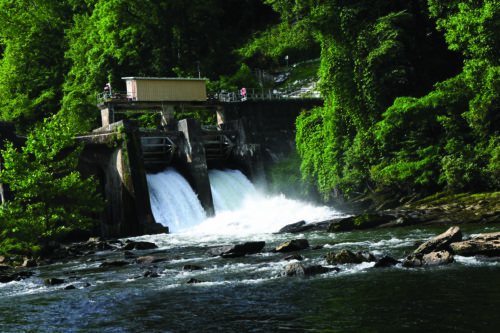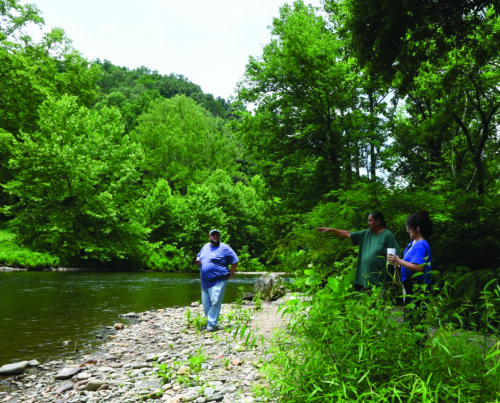By MATTILYNN SNEED
One Feather Intern Reporter
CHEROKEE, N.C.- Dinilawigi (Tribal Council) held a work session on June 11 to hear from community members and environmental organizations regarding issues surrounding the Ela Dam and the possibility of its removal.
The Ela Dam was constructed in 1925 and is the only obstruction in the 18 miles of the Oconaluftee River. It has changed hands several times over the years, with Northbrook Carolina Hydro purchasing the dam in 2019. On Oct. 3, 2021, a gate system software malfunction resulted in an accidental sediment dump that smothered the streambed below in 18-24 inches of sediment. This had serious effects on the health of the section of river downstream of the dam.

Dinilawigi (Tribal Council) held a work session on June 11 to hear from community members and environmental organizations regarding issues surrounding the Ela Dam and the possibility of its removal. (MATTILYNN SNEED/One Feather photo)
The disaster started a conversation about the viability and negative side effects of the dam. Joseph Owle, the EBCI (Eastern Band of Cherokee Indians) Secretary of the Division of Agriculture and Natural Resources (DANR) at the time, submitted Res. No. 159 (2022), calling for the formation of a coalition for the removal of the dam. The resolution was approved by Dinilawigi Feb. 3, 2022.
Owle submitted Res. No. 312 (2022) to Dinilawigi on June 2, 2022, which called for the EBCI to purchase the dam with the intent of removal. It stated that DANR had determined funding sources and drafted documents to purchase the dam from Northbrook Carolina Hydro. With a vote of 44 yes, 50 no, and 6 absent, the resolution did not pass. Those who voted against it cited concerns over liability, cost, and effects on landowners bordering the lake.
About a year later, Owle stood before Dinilawigi again, this time to discuss Res. No. 615 (2023), submitted by Renee Gurtler, grants manager on behalf of the EBCI Natural Resources Department. Owle told Dinilawigi that he asked Mainspring Conservation Trust to take lead on the project after the rejection of Res. No. 312 (2022). Under the oversight of Mainspring, the coalition secured $8 million in funding for the dam removal and river restoration; $4 million from U.S. Fish and Wildlife and $4 million from the N.C. Wildlife Resources Commission. The resolution committed the EBCI to a memorandum of agreement to accept the $4 million grant from N.C. Wildlife Resources Commission to support the removal project. The resolution passed May 30, 2023.
In the time since the passing of Res. No. 615 (2023), Mainspring and EBCI Natural Resources have been working to move the project forward. The June 11 work session began with Mike LaVoie, director of EBCI Natural Resources, briefing Dinilawigi on the circumstances surrounding the state of the dam, as well as the environmental impacts.
“This dam continues to alter the natural, physical, biological, and chemical composition of the entire river system, and continues to be an impediment to the health of the river in the long term,” said LeVoie.
He said a primary negative effect of the dam is the prevention of migration by native fish to the Cherokee waterways. The dam has been particularly detrimental to the sicklefin redhorse, a fish that is a vital part of the river’s ecosystem as well as Cherokee culture.

Kenneth Panther (green shirt) explains to EBCI Natural Resources Department staff how the erosion has impacted his property. Shown, left to right, are John Tahquette, Panther, and Aubrey Acuma. (MATTILYNN SNEED/One Feather photo)
Jordan Smith, executive director of Mainspring Conservation Trust, addressed Dinilawigi to explain the nonprofit’s mission statement and their vision for the project.
Mainsprings’ purpose, Smith said, is to conserve the waters, forests, farms, and heritage of the upper Little Tennessee and Hiawassee River Vallys. Smith acknowledged the negative impacts that this removal could have on some land-owners on the reservoirs edge, but thinks it would be worth it for the greater good.
“Protecting cultural resources and connecting people to those resources is at the core of what we do,” Smith said in reference to the importance of restoring the sicklefin Redhorse habitat.
The Earth Keepers also made an appearance to voice their support for the project, citing the health of the river and wellbeing of the aquatic life.
The fish are not the only ones being negatively impacted by the disruption to the river’s natural flow.
Kenneth Panther, an EBCI tribal member, is just one property owner whose land has suffered significant erosion by the high waters that are a side effect of the dam. This problem is compounded with an island that has formed in the middle of the river that forces the water against his bank. He says the bank once extended 10 to 15 feet further into the river than it does today. Panther tried to stop the erosion by installing boulders but was forbidden because it would obstruct the floodway. Whether it was removing the dam or the island, he could work with either one, he said, but his riverbank couldn’t wait the years it could take for the dam to removed.
Panther also expressed concern over what will happen to his property line should the dam come down.
Smith said, at least in the beginning, property owners will possibly have land between theirs and the river that does not belong to them. This is so that Mainspring would have access in order to complete restoration projects upstream. If the land were transferred to the tribe upon completion of the project, it would be under their jurisdiction to decide how to handle property lines.
“This is also a land back initiative. This is 68 acres that could potentially come back to the tribe, along with a mile and a half of river,” LaVoie said.
Smith echoed that it is Mainspring’s intention to return the land upon the project’s completion. “At the core of this project is the potential rematriation of these lands…and I say potential only because I don’t want to get ahead of decisions of the tribe or Mainspring, but that is the intent,” Smith said. “The potential for [the 68 acres of land] to be back into tribal hands is the embodiment of all thee parts of our mission.”
Julie Gantenbein, the legal counsel speaking on Mainspring’s behalf explained that the sediment release incident brought to light the fact that the dam is at the end of its useful life. As dams age, they become more expensive to maintain and 100 years exceeds the average life expectancy of a dam in the US. “You’re seeing increasing risks and cost, and decreasing benefits,” Gantenbein said.
Northbrook applied to surrender its license to the Federal Energy Regulation Commission (FERC) in November 2023, which if granted will disconnect the dam from the grid, but not result in any kind of dam removal. “The intent is to surrender the license, terminate federal jurisdiction, transfer the dam into state jurisdiction, and only then would ownership rights be able to transfer to someone other than Northbrook. Then we could begin to consider dam removal…Once FERC’s jurisdiction ends, Northbrook has committed to selling the project to Mainspring,” Gantenbein said.
Ben Lassider, deputy director at Mainspring, informed Dinilawigi that the dam removal will likely cost around $20 million. Some of those costs would come from upstream restoration. Current projected dates included dewatering by 2026, removal of dam and site restoration by 2027, and upstream restoration from 2028 and beyond.
Smith said that there are hundreds of millions in federal funding available through the Bipartisan Infrastructure Law, US Fish and Wildlife Services, US Forest Service, and others. Over $12 million has been committed to the project so far.
The dam project is not without concerns and drawback, the primary example being land-owners upstream.
Phillip Armachain Sr. is an EBCI tribal member who owns lakeside property on which he says he’s built his business and legacy. Starting in 2005, he spent eight years building the cabins and boat docks that have become his livelihood. Armachain said he doesn’t disagree with the dam removal, but that he’s also feeling nervous and frustrated.
“I’m not against all the people who have told us about all the important issues concerning the restoration of the river. I appreciate them and what they’re doing for us. However, there are some negative impacts. It’s been some time since all of this has come up and I’ve been waiting for someone to address these issues that are so important to me and my family,” Armachain said.
Mainspring will be obligated to obtain permits and mitigate any impacts to land-owners who will be affected, Gantenbein said, and that they are committed to executing the project in a way that is beneficial to the community.
LeVoie said that he and Smith visited Armachain’s property to hear his concerns, saying, “These are the types of things we’re working to understand and garner resources for, to come up with solutions that can meet everyone’s needs. It’s not going to be a perfect fit for everyone. We’re trying to do something for the greater good…As we gain resources to do better planning, we can continue to work with the land- owners and tribal leadership to try to get solutions that help them but also allow us to get this greater good done for the ecosystem.”





